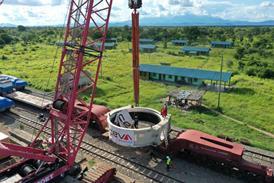April 15 - Intermarine's Industrial Eagle has called at the US West Coast port of Olympia, Washington to discharge wind turbine components from Brazil. When discharge was completed, the ship was positioned to the Far East to join the line's intra-Asia ser
The Industrial Eagle was the first in a series of four newbuildings entering the Intermarine fleet in a period of 12 months. Designated as the E-class vessels, these 10,000 dwt ships feature dual 250 tonne cranes that may be combined for 500 tonne lifts. A second vessel, the Industrial Egret was delivered in late February, with the two remaining vessels delivering in intervals of three to four months.
The movement comes against the background of a changing market for imported finished wind power generating equipment into the USA. At the end of 2008 the US overtook long-time leader green champion Germany in terms of quantity of energy produced and cumulative wind power generating capacity. The US produced a total of 25,369 MW, ahead of Germany's 23,902 MW. The US also beat China to become the world's largest market in terms of new installations, installing 8,545 MW, ahead of China's 6,300 MW.
Where previously this demand had to be satisfied by imports, the movement of which has and continues to provide a lucrative haul for heavy lift shipping lines, market analysts have long predicted that US indigenous production of turbine and turbine components would replace imported products. Out of the top ten global utility-scale wind turbine manufacturers in 2007 - Vestas, GE, Gamesa, Enercon, Suzlon, Siemens, Acciona, Goldwind, Nordex, Sinovel - six now have a US manufacturing presence, soon to be followed by a seventh.
According to The American Wind Energy Association, domestic US production is also proving positive to the US job market. Wind power created 35,000 jobs in 2008 alone despite the economic downturn and provided a broad range of business and employment opportunities in different regions of the country. About 85,000 people worked in the wind energy industry as of the end of December 2008, up from 50,000 in 2007. Significantly, many of those new jobs are in manufacturing.
















